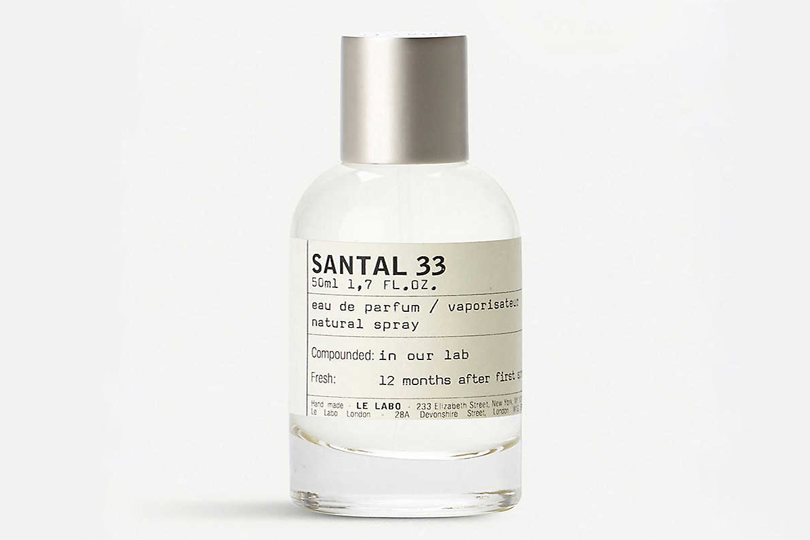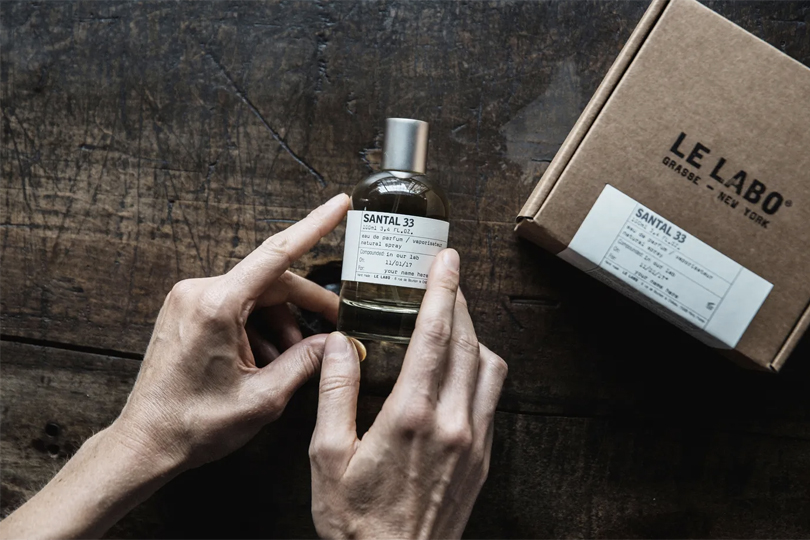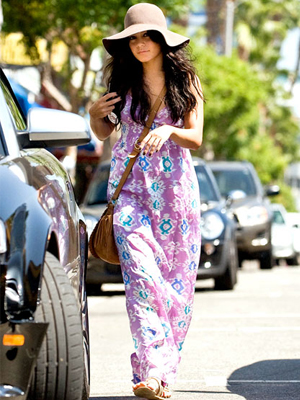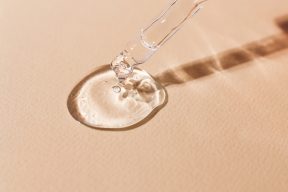Part of an ongoing series of 29Secrets stories, taking a deep dive into the history of legendary beauty products and iconic fashion moments…
By Christopher Turner
Illustration by Michael Hak
No doubt you’ve smelled the secret-not-so-secret scent of Santal 33. The slightly sultry, smoky scent usually floods high-end hotel lobbies, and it is the fragrance of choice of fashion insiders and countless celebrities, including Meghan Markle, Alexa Chung, Brad Pitt and Justin Bieber. It’s an iconic unisex fragrance that is instantly associated with luxury and whose appeal seems to span ages and genders. Of course, that chic association with luxury doesn’t come cheap: in Canada, a 100 ml/3.4 fl oz bottle will set you back $390.
For anyone new to the scent, Santal 33 features a warm and niche blend of cardamom, iris and violet with a crackle of smoky Australian sandalwood and cedarwood, and finished with spicy and leathery perfume notes of musk. However, the fragrance itself isn’t new – it was launched well over a decade ago by Estée Lauder Companies-owned perfume brand Le Labo – yet its unique scent has managed to secure the kind of longevity that rarely happens in perfumery. And that longevity shows no signs of slowing down as the scent’s cult-like status, it seems, only continues to grow alongside the “quiet luxury” trend that continues to dominate the fashion world.
“We are lucky at Le Labo to have a few ‘cults’ in our collection,” Le Labo co-founder and perfumer Fabrice Penot told the New York Times back in 2015. “But Santal 33 is another level of success; it has had a stupid amount of success. As a perfumer, you always secretly hope, but you never expect, [to have] such an impact. It happens once in a lifetime – if you are very, very lucky.”
Obviously Santal 33 is a brand bestseller, but it was never even meant to be a perfume: the scent was originally earmarked for an unsuccessful candle line, and only migrated to the perfume collection after its popularity popped out of nowhere.
With the “quiet luxury” trend showing no signs of losing steam, and the slightly sultry, smoky scent trending (yet again), it’s time to take a peek into the history of Le Labo’s Santal 33, the internet’s favourite fragrance and current obsession.
Creating a scented revolution
Le Labo was founded in 2006 in New York City by Fabrice Penot and business partner Edouard “Eddie” Roschi, who became fast friends while working with the luxury Italian house Giorgio Armani. They wanted to create a scented revolution in the often-traditional world of perfumery. So, with no formal investor funding and no advertising, the pair opened their first lab at 233 Elizabeth St. in the trendy Nolita district of New York City. The store featured a lab-like concept, influenced by Roschi’s background in chemistry, with each fragrance hand-blended in-store upon purchase, then packaged in a brown box and given a customized label.
The boutique brand originally launched with 10 fragrances and one scented candle, all vegan and named with numbers in a nod to the distinct codes used during perfumery making. Rose 31 was an early best seller that helped spread the word across New York City.
“So if I had to give two fragrances pride of place, I’d say I’m fond of Rose 31 for the formative role it played in establishing our business, and of Santal 33 for the way in which it has come to define our brand,” Roschi said in 2018. “Every other formula we created has its function, but these two scents were pivotal.”
Le Labo’s later success, much of which is attributed to Santal 33, ultimately catapulted the brand into the big leagues, and in late 2014, beauty conglomerate The Estée Lauder Companies acquired the company for an undisclosed amount (according to WWD, the amount was a staggering $60 million). The deal allowed Penot and Roschi to continue creating the scents and remain true to their founding manifesto, allowing the brand and its artisan products to remain independent while letting Estée Lauder handle the business logistics, including expansion.
“I firmly believe that creation is an autocracy; it’s not a democracy,” Roschi said in an interview in 2018.
Estée Lauder was able to help Le Labo gain traction across the globe – including Canada, although in fact we were early adopters of the scent. Le Labo fragrances first became available in Canada in 2010, when Toronto-based 6 by Gee Beauty (at 6 Roxborough St. W. in the affluent Rosedale neighbourhood) began carrying the line exclusively. That exclusivity was lifted after the Estée Lauder deal, when Nordstrom opened its CF Pacific Centre flagship in Vancouver in September 2015. The fragrance brand slowly increased its footprint as Saks Fifth Avenue opened across the country and as Nordstrom continued its expansion into Canada (Editor’s note: Nordstrom ultimately closed all Canadian locations in June 2023). Le Labo opened their first Canadian freestanding store in 2017 with a boutique located at 876 Queen St. W. in Toronto, and their second location two years later on the other side of the country at 225 Carrall St. in the historic Gastown area of Vancouver. In late 2022, Le Labo opened a third Canadian location in Toronto’s Bloor-Yorkville area.

Santal 33
Now, on to the story of the beloved scent that changed everything for Le Labo. When Le Labo first launched in 2006 with 10 personal fragrances and one sandalwood-scented candle, Santal 33 wasn’t included…the personal perfume didn’t officially launch until 2011. The fragrance, however, is part of the brand’s initial DNA via that one candle, the Santal 26 candle, which is the precursor to Santal 33.
When Le Labo opened the doors to its Nolita store, The Cut’s beauty editor-at-large Jane Larkworthy (who at the time was beauty director at W Magazine) wrote that customers were charmed by the fragrances and their labels, which were customized by the wearer’s name and an expiry date – but the candle just sat there unnoticed until hotelier Ian Schraeger encountered it. Schraeger ordered a run of similar, but smokier, custom candles from the brand for the Gramercy Park Hotel, which he was in the process of renovating into a fashion hot spot. When customers started turning up at Le Labo’s store looking for the cozy scent they had smelled at Gramercy, the brand realized they might have a winner on their hands.
“We were like, ‘That’s exclusive to the hotel, but we have the mother of it!’” Penot recalled. He would tell people that the Santal 26 candle would be restocked soon, maybe in a few months. Then he and Roschi invested in a new production run of the candles and later a room spray, which would go on to represent about 70 per cent of the brand’s turnover for the first two to three years.
The Santal 26 candle was an instant hit. Jennifer Lopez was such a fan that when it was finally restocked, she would buy “100 candles every month, sometimes 200,” said Penot. (J.Lo now apparently orders 50 jars of the candle every month.)
At the same time that J.Lo and others were buying and burning the candle, others – including Larkworthy, who was an early supporter of the brand over at W Magazine – had started smearing the candle wax on their necks, totally intoxicated by the candle’s smoky and sandalwood-y scent.
But, Penot remembered, “we ignored the few friends, including [Larkworthy], who said, ‘You should go for a perfumer version.’”
In fact, the brand didn’t decide to move forward with a wearable version of the Santal 26 candle scent until a warm June afternoon in 2010, when Penot stopped at the corner of Prince and Mott in New York City to join a small crowd that was watching the World Cup on a TV screen inside:
“I try to focus on the game, but something is bothering me. The guy in front of me smells amazing. I am the weirdo who can’t get enough of his smell and starts getting closer and closer, enjoying every whiff from it.”
He finally mustered up the nerve to ask the man why he smelled so good.
“The guy was French and he answers, kind of embarrassed, ‘Well, it is actually not a perfume…it is a room spray. I buy it at that little store on Elizabeth.’”
“I was like, What? The genius who made that perfume I wanted to knock off is me? Shiiiiiit.” He called his business partner immediately. “We have our next perfume, and it has actually always been there the whole time. It is Santal.”
Penot and Roschi immediately reached out to perfumer Frank Voelkl, who had created the original, discarded sandalwood fragrance, as well as the candle. “I was actually wearing the fragrance quite often, and I always received comments,” recalled Voelkl. “I would, of course, not give it to anyone else, but over the years I tried to convince Fabrice to sell it. The candle was paying their rent, but maybe he wasn’t sure what would happen if they made a perfume out of the scent. Would one take away the allure from the other? He had not been very keen on going there, but when he smelled that guy wearing the room spray, that was the trigger.”
Voelkl tweaked the original mix and by 2011, Le Labo released the wearable personal perfume Santal 33, a creation that quickly changed the brand’s trajectory. Santal 33 quickly gained cult status, then grew into broad popularity.
An article in the New York Times from November 2015 described the scent: “Like an under-the-radar It bag prized for its unidentifiable features and nondescript branding, Santal 33 quickly became a sort of cult secret, whispered through wafts of sandalwood and cedar, only detected by those in the know.”

Pop culture
Le Labo’s legendary fragrance has come to be known as “that perfume that you smell everywhere,” which is a tad ironic because it became popular for not smelling like anything you’ve ever come across. Its unwavering popularity might make you wonder, do we ever escape the enduring ubiquity of fashion’s favourite cult fragrance? Probably not. It remains a constant on almost every editor’s favourite fragrance roundups, from Vogue to GQ.
A few memorable examples: in Beyoncé’s 2016 visual album Lemonade, the singer was depicted burning two Le Labo Santal 26 candles during the sequence for “Sandcastles.” On television, the Santal 33 bottle was placed front and centre in Season 2 of The Flight Attendant in the episode “Backwards and Forwards” (which aired in 2022), and, most recently, the scent got a shout-out in a key scene in Red, White & Royal Blue, the surprise LGBTQ+ bestseller adapted for the small screen by Amazon Prime. When Prince Henry (Nicholas Galitzine) leans over to America’s First Son Alex (Taylor Zakhar Perez) and says, without hesitation, “Santal 33? Makes sense.” “What do you mean by that?” Alex demands, to which Henry replies: “It means you’ve got good taste, Alex.”

The scent also dominates on social media. On Instagram, a search of the #santal33 hashtag reveals 32.5k posts showing off the beautiful bottle, while over on TikTok, Santal 33 has found a whole new audience, with thousands of videos supplying us with a number of Le Labo Santal 33 dupes to rival the iconic unisex skin scent.
What’s next?
Today, Santal 33’s instantly recognizable blend of sandalwood, cedarwood, cardamom, iris, ambrox and violet can be detected seemingly everywhere. And as the scent exploded, so did the brand, playing a pivotal role in reshaping the conversation around niche perfumery – a product category that accounts for over 10 per cent of sales in the wider US$26 billion industry. The brand itself has grown internationally: Le Labo currently operates dozens of stores internationally, as well as shop-in-stores in leading retailers across the world that all operate as perfumers’ labs to focus on the craftsmanship that goes into creating their now 17 signature, unisex scents. For their parts, Penot and Roschi are still involved but are also doing other things, and Voelkl continues to create scents for the brand.
Since its official 2011 release, Santal 33 has persisted as one of beauty’s most ubiquitous It-girl (and guy) fragrances, something that is unlikely to change any time soon. Santal’s success ultimately means that the brand and their other niche artisan scents are often overshadowed, something Penot has acknowledged.
“We owe a lot to Santal, but we would also be very happy without it – we have a family of scents we are proud of and are sometimes overshadowed by Santal,” Penot has said.
It turns out that the scent of success is in fact bittersweet: “That’s the price every creator has to pay when something takes off,” he added. “This is what happens when the rule-breaker makes it big.”
![]()
Want more? You can read other stories from our The Story Of series right here.











